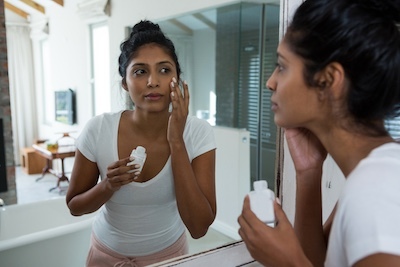Combating Acne Head On
 June is Acne Awareness Month, and if you are one of the millions of Americans struggling with acne, you don’t need a special month of awareness- you see it every day! Achieving clear skin doesn’t have to be out of reach. Since breakouts can range from mild to severe, there are many different options for treatment. We often head straight to the local pharmacy once we feel a breakout start to pop up, but there are so many different options, with some in fancy packaging camouflaging ineffective ingredients. How do you know which one to choose? Can you layer on 10 different creams hoping it goes away tomorrow? The answer isn’t so simple. Let’s dive into a discussion about the different causes of acne.
June is Acne Awareness Month, and if you are one of the millions of Americans struggling with acne, you don’t need a special month of awareness- you see it every day! Achieving clear skin doesn’t have to be out of reach. Since breakouts can range from mild to severe, there are many different options for treatment. We often head straight to the local pharmacy once we feel a breakout start to pop up, but there are so many different options, with some in fancy packaging camouflaging ineffective ingredients. How do you know which one to choose? Can you layer on 10 different creams hoping it goes away tomorrow? The answer isn’t so simple. Let’s dive into a discussion about the different causes of acne.
How acne is formed
While the exact causes of acne have not yet been 100% identified, there are several factors that contribute to the development of breakouts. Changes in hormones cause increased production of oil, or sebum, in the skin. When pores get clogged with excess oil and dead skin cells you now have the perfect storm to create blackheads and whiteheads. Clogged pores are also the perfect breeding ground for bacteria to create inflammation, creating deep painful cysts. Acne can also be triggered by stress, pore clogging makeup, and oral medications. Blackheads and whiteheads don’t occur only on the face. They can also appear on different parts of the body, on the back, chest, shoulders, arms, and necks.
There are two types of acne: Inflammatory acne and non-inflammatory acne
Non-inflammatory acne pertains to clogged pores. Clogged pores fall into two different types- blackheads and whiteheads. Blackheads occur when a clogged pore is open. The combination of oil and dead skin cells meet the air causing it to look dark. Whiteheads are clogged pores that are closed, which creates the appearance of a white bump. Inflammatory acne often consists of red, inflamed lesions that look like large whiteheads. There are different types of lesions that can occur in inflammatory acne. Papules are red bumps that are deep under the skin’s surface. Pustules are large, painful bumps that are filled with pus. Nodules are large, very hard bumps. Cysts are large, pus filled bumps that are like boils. Nodular and cystic acne are the most severe types of acne that can cause permanent scarring and should immediately be treated by a dermatologist.
How do acne treatments work?
Acne treatments are designed to attack one or more of the underlying factors that is causing you to break out. Topical therapies are often the first line of defense and can be the most effective depending on the severity of your breakout. The most common topical therapies are retinoids, salicylic acid, and benzoyl peroxide. Topical retinoids work to unclog pores, which can help other topical therapies work better. They can also reduce future acne breakouts by preventing the pores from clogging. Most topical retinoids are prescription strength, but there is an OTC option- adapalene. Retinoids can make your skin dry and irritated, so it is important to follow the application directions, so you do not further irritate your skin. Also, using a daily sunscreen while using retinoids is important because the product can make your skin more sensitive to the sun. We recommend a broad-spectrum sunscreen with at least an SPF 30 for optimal protection.
The top acne-fighting ingredients
Salicylic acid is a beta-hydroxy-acid. It works by exfoliating the skin and keeping pores clear. Most OTC (over-the-counter) acne products contain salicylic acid as it works great for mild breakouts. It works great for blackheads and whiteheads and may also prevent future breakouts with consistent use. It can also be a little drying, so a little bit goes a long way. Benzoyl peroxide is more drying than salicylic acid, which makes it best for more traditional pus-filled pimples. In addition to unclogging pores and eliminating dead skin cells and oil, it also helps to kill acne causing bacteria underneath the skin. Benzoyl peroxide can bleach your clothes and pillowcases, so it is best to make sure that your hands are thoroughly washed after you use the product as well as to wait until your face dries completely before going to bed. While it might sound great to mix them all together to create a mega dose of acne fighting creams, you can actually do more harm than good in that one. Using too many or combining, products without guidance from a dermatologist can severely dry out or even burn your skin. If your skin is too dry, your skin will start producing more oil to combat the dryness and could potentially cause an even bigger breakout to happen. It’s also very important to remember that acne medications can take at least a few weeks to show improvement in the skin. Some medications and topical creams can take up to 12 weeks to show results.
When to see a dermatologist for acne
If your skin stops improving or doesn’t improve at all, it’s time to make an appointment to see a dermatologist. Oral prescription therapy may be added to your topical regimen to help clear the breakout. Oral antibiotics work to reduce inflammation and kill the bacteria that causes acne. For women, spironolactone may be prescribed to help reduce sebum levels in the skin. For severe cases of inflammatory nodular or cystic acne, isotretinoin may be prescribed. Isotretinoin can cause severe side effects as well as birth defects in pregnant patients, so there are special regulations that must be followed when taking prescribed these medications.
Dealing with acne scars
As if having breakouts weren’t bad enough, the scars that can be left behind can be even more frustrating. All acne scarring occurs when a breakout damages the tissue beneath and around it. The dark marks that are left behind, after the pimple that you picked, is not an acne scar, just discoloration of the surrounding skin. Those spots typically fade within a few weeks or months. Cystic acne scarring is severe, and if left untreated becomes increasingly difficult to treat. Depressed scars are the most common, also known as atrophic scars. Depressed scars go deep into the skin and occur when the tissue around the cyst is not healing properly. They can be shallow or deep and they can also look like holes. It is so important that you do not pick or pop any acne lesions to avoid these scars and marks from forming. Learn more about treating acne scars.
Chemical peels for acne scars
In-office treatments for acne can also be used as a super charged booster to your treatment regimen. Chemical peels are one of the most common treatment boosters. Chemical peels are comprised of gentle acids that help exfoliate the top layers of the skin to help unclog pores and begin to improve deeper scars. Chemical peels are made in different strengths and penetrate to different levels of the skin, so it is important to ensure that you are having them performed by a trained professional to avoid further scarring or other complications. They are often performed in a series of 3-5 monthly treatments
Laser treatments for acne
Lasers and light-based therapies can also help to improve breakouts and scarring. Light-based treatments work on killing the bacteria that causes the cysts to develop as well as calming inflammation of the larger deep cysts. Lasers are used to resurface the skin which helps to improve the appearance of the deep scars. However, laser resurfacing can only be done once an active cystic breakout is cleared. A series of treatments (often 5) are recommended, and improvement happens over time and varies from patient to patient.
Is acne preventable?
One of the big pressing questions left is can you prevent acne? The answer to that is yes and no. Let’s start with the no. Acne may have a hormonal component to it. Lab tests will be needed to determine if that is the case and from there have your treatment plan must address that component. Cystic acne can also be genetic. If a parent had cystic acne, the likelihood of you developing it is higher. Bottom line- there are some things you cannot control in the development of acne. Now the yes! Having a good foundational skincare regimen and lifestyle routine will help to reduce some of the contributing factors that cause acne. Choosing products that are geared toward acne prone skin are important in helping keep the skin clear. Use gentle foaming cleansers that both remove excess oil but don’t dry out your skin. Avoid exfoliating your skin more than once a week. Do not use harsh sponges or mechanical brushes as these can also dry out your skin. If you wear makeup, make sure that you are using products that are labeled “oil free” and “non-comodogenic.”
Acne fighting tips
It’s also very important to be aware of bacteria traps like sheets, pillowcases, towels, and masks. Make sure that you are changing your sheets and pillowcases weekly to avoid sleeping on accumulated bacteria and dead skin cells, which we know are the pore clogging culprits! As we enter what hopefully are the final stages of the pandemic, if you are still required to wear a mask, ensure that you are washing cloth masks twice a week with gentle detergent or switch to disposable masks to change daily. Lastly, as hard as it is, it’s very important to avoid touching your face during the day, as germs and bacteria are carried around from everything we touch.
While there is no magic bullet to treating acne there are certainly ways to get clear, healthy skin. If you think you are starting to experience more persistent and severe breakouts that are getting worse, it is time to schedule an appointment with a dermatologist. With a proper treatment plan, and following these tips, you can help keep it clear!
Schweiger Dermatology Group features world renowned experts in the field of medical and cosmetic dermatology. Our talented team of providers will help you on your self-care journey by bringing your skin back to life. With over 160 offices and more than 600 healthcare providers around New York, New Jersey, Long Island, and Pennsylvania, we offer same day appointments both in office and via video visit. The health and safety of our patients is staff is our top priority, so our offices are employing enhanced safety measures should you prefer to be seen in office.
While we are doing our best to protect one another, it is important that we take the time to take care of ourselves. Call 844-DERM-DOC or go online today to schedule an appointment to achieve healthy skin.
